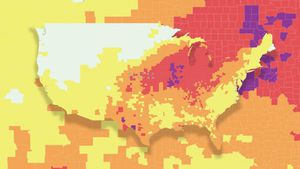In the small town of Chililabombwe, Zambia, digital screens in California revealed an extraordinary discovery. A rich deposit of copper, deep underground, had come into focus, thanks to advanced AI-driven technology developed by KoBold Metals. The size and richness of this lode could potentially make it one of the largest copper finds in over a decade, reshaping the global landscape for critical mineral resources.
The find is more than just a massive economic boon; its geopolitical implications are vast. The United States and China, two superpowers locked in a battle for mineral supremacy, both have immense interest in the metals essential for clean-energy technologies. As a result, many eyes are now turning to Zambia.
KoBold Metals' journey began half a decade ago, spurred by the needs of Silicon Valley’s biggest players. Their high-tech business empires rely heavily on scarce minerals like copper, cobalt, lithium, and nickel. The increasing demand for these resources stemmed from everything from smartphones to electric vehicles, and even the massive lithium-ion batteries that stabilize power grids.
“The more you realize how dependent we are on these technologies, the more you ask: How the hell were we so slow to the fact that we needed vast amounts of raw material to make it all possible?” Connie Chan, a partner at Andreessen Horowitz, remarked. This realization led to KoBold’s innovative exploration techniques that combine aerial surveys, advanced data analytics, and AI-driven predictions to locate underground mineral deposits.
KoBold’s find in Zambia is expected to produce at least 300,000 tons of copper annually once fully operational. Over two decades, that translates to enough copper for 100 million electric vehicle batteries. With investors like Bill Gates and Sam Altman backing them, KoBold’s ambition knows few bounds.
However, while the financial rewards for KoBold and its investors are potentially enormous, the question remains: Will Zambians see the benefits? History hasn’t been kind to the local populace when it comes to mining profits. Despite a wealth of copper, Zambia remains one of the world’s least-developed and most indebted countries.
Grieve Chelwa, a Zambian economist, poignantly noted, “The value of copper that has left Zambia is in the hundreds of billions of dollars. Hold that figure in your mind, and then look around yourself in Zambia. The link between resource and benefit is severed.” KoBold’s investment does involve the Zambian state mining company, which owns a 20 percent stake, but there's no guarantee this will lead to substantial improvements for everyday Zambians.
KoBold’s technological edge is vast. From digitizing old maps to developing sophisticated tools like the muon detector, originally used in Egypt to find burial chambers, the company integrates various innovative approaches. Tom Hunt, leader of KoBold’s data science team emphasized, “We think we’re mostly done with the easy era of mining.” But it also means fewer employment opportunities for locals, given the efficiency-driven nature of underground mining operations.
Adding to the complexity, Zambian President Hakainde Hichilema has been negotiating for a larger share of the mine for the state. He believes the increased stake would bring more financial stability to Zambia, allowing for investment in vital sectors. Yet, the benefits for Zambia seem, at this point, theoretical.
For the United States, KoBold’s success represents a strategic victory. Jennifer Fendrick, KoBold’s director for government affairs, boasted, “We are the American beachhead in Africa.” This statement underscores the U.S. government’s partial underwriting of a $2.3 billion railway to facilitate the transportation of copper from Copperbelt Province to the Angolan coast.
However, the global quest for critical minerals doesn’t end in Zambia. Neighboring Congo’s cobalt reserves remain largely controlled by Chinese firms, complicating U.S. efforts to secure essential resources. As Jose W. Fernandez, the State Department’s top energy official, explained, “We need 25 times as much cobalt as we currently mine, not to mention all the other metals and minerals reshaping the global economy.”
The stakes for securing these resources are high. Future U.S. policies, particularly post-2024 election outcomes, could dramatically alter the advancement of renewable energy goals. Whether it’s through deep-sea mining, overcoming domestic objections, or international partnerships, the pathway is fraught with challenges.
In the offices of KoBold, as data scientists meticulously analyze geological data, and engineers prepare for the monumental task of extracting Zambia’s copper, the future hinges on equitable resource allocation. Kennedy Bondolo, a local from Kawama village, captured the local optimism: “With a new mine, maybe our village will become a real town.”




